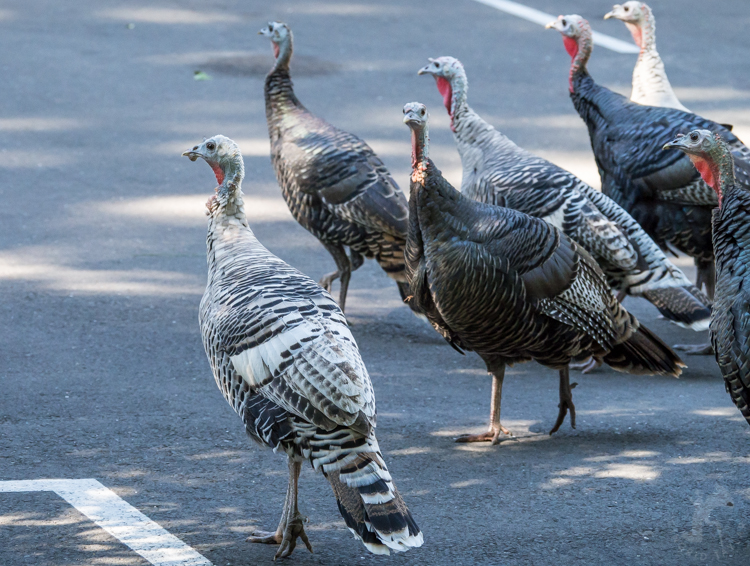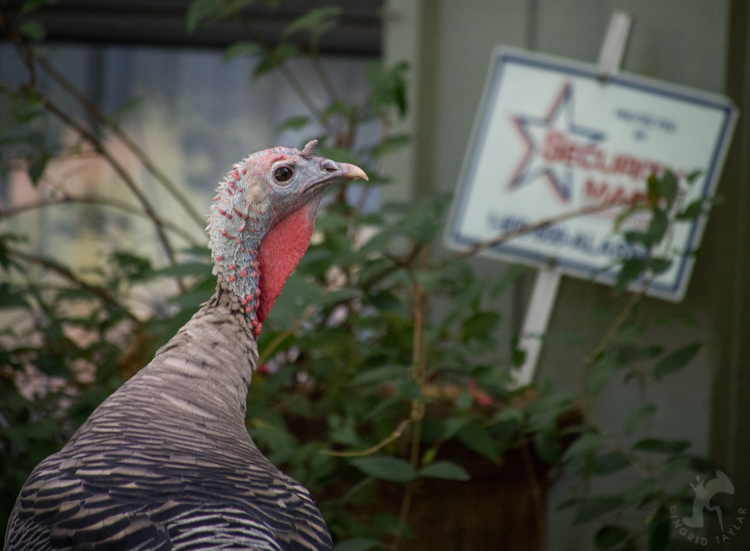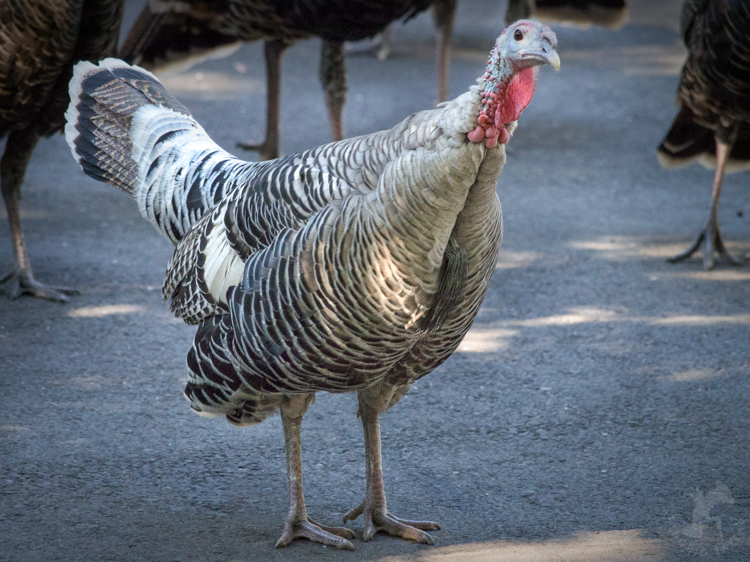White or Smoke Phase Turkeys
The color white represents catharsis in alchemy. It’s the point at which a blackened substance, through heat and reactivity, develops a white crust and then puffs into a cloud inside the alchemist’s flask. It’s the stage at which future possibilities become apparent as a material is transformed from one to the other. And it’s symbolized by a white swan or white eagle.
In Arthurian tales, it was believed the elusive white hart (or stag) could not be caught. The white hart symbolized a never-ending quest for knowledge, for the unattainable.
In Celtic myth, a white boar led St. Cadoc and his monks to the proper building site of his future monastery.
Caladrius, the snow-white bird of Roman mythology, could draw illness from a man by just looking at him, then send the ailment adrift into the burning sun.
White animals are mystical, transformative, spiritual and sometimes foreboding in ancient yarns. Pegasus and unicorn — white horses, winged or horned — both elevated heroes, goddesses and saints above the fray, upon their magical hooves.
So, what was I to think when I saw the White Gallopavo? Was she, too, signaling catharsis and transformation — leading me to great fortune or to my preordained fate? And if so, when I write my own personal myth, will I tell people that I met my true destiny while crossing the roundabout of a California housing development?
Here’s the vision of White Gallopavo — the whitest I have ever seen.
In fact, this is the only white Wild Turkey — Meleagris gallopavo — I’ve ever seen. And this bird was shadowed by three flock-mates in various stages of similar whiteness.

This group of Wild Turkeys roams my friend’s California neighborhood, a location I won’t disclose simply because I hear these white birds are sometimes coveted by the wrong people.
The turkeys forage for greens and snails and other items on the suburban/urban lawns, all under the generally appreciative watch of local residents.

Contrary to popular impression, there is apparently no evidence that these birds are wild-domestic hybrids — breeding with white farm turkeys. They are known as smoke-phase or white-phase turkeys, exhibiting the color traits of a recessive gene. The majority of white Wild Turkeys are also female. This turkey appears to have a beard but no spurs and perhaps a few feathers on the head. Would you identify it as a male?

In Native American texts, Turkey had grand responsibility, either as the bearer of flame or the giver of agriculture.
A White Mountain Apache tale about the origin of corn describes how Turkey gave corn to human beings by shaking seeds of the four different colors of corn—black, blue, yellow, and white—from his feathers. In a Cherokee myth, when Turkey gave fire to the world he singed off his head feathers, which explains why turkeys are bald.
~ Patricia Ann Lynch in “Turkeys in American Indian mythology,” Native American Mythology, Mythology A to Z.
In one Seminole story I read, Turkey got his beard by way of a scalping. In a Cherokee story, Turkey convinces a Terrapin to hand over a scalp that Terrapin brought back from war. The Wild Turkey’s history is animated through myth, integral as animal spirits are in cultures beyond our own. They reside alongside human animals as messengers, deities, tricksters and teachers. And, in the case of white animals, they are uncommon enough as to stir imaginings of grandeur.
We ambled alongside our turkey companions who seemed to mind us none. Like uninvited busy bodies, we held traffic for them on a road where the turkeys, accustomed to this neighborhood, had crossed a thousand times without our assistance.
Above a parking lot, they saw this specter in a tree long before we did. They turned a collective eye upward, guiding our own eyes to the yellow talons.

At that point, we left the turkeys — white, gold, black and red — to graze in peace on the median, as the Red-shouldered Hawk flew out from under the gaze of ten turkeys and three humans. Whatever significance I might assign to the Great White Gallopavo, as soothsayer or symbol, a Wild Turkey is a natural enchantment regardless. We used to listen for them in the California brome, sage and chaparral of the Berkeley hills. We’d often find them, too, at sunset, roosting on rooftops, shrouded in San Francisco fog, draped in whiteness — and looking, actually, like giant cloud puffs in an alchemist’s flask.

This is beautifully written Ingrid; November the 28th is approaching, and your images of these majestic birds break my heart. Thanksgiving day. Why should it be abolished? IMOHO it is an outdated philosophical tradition to commemorate a day in North American history. Why continue? Shouldn’t we all be thankful each and every minute of our existence? It reminds me of the scapegoating theory and how humans continue to do this, either at the conscious or unconscious level. Education does not suffice with this group; culture, norms and tradition override people’s lives; and some people love it. It gives them a sense of purpose, a structure, security perhaps. Perhaps the question to ask is: why is homo sapiens sapiens, the traditional animal?
Maria, I understand those sentiments. I used to live in an agricultural area where I’d see the slatted trucks bursting with cows, pigs and chickens, travel by on their way to a nearby slaughterhouse. It seemed always to be under the cover of night, but I was a night owl, so my vision defied the purpose of this cloaked transport. I didn’t purposely shield myself from the violence of that place. I wanted to make sure I never lost sight of those images and never allowed myself to feel fully whole as long as my heart was breaking into pieces over those scenes. The odd thing about Thanksgiving is that the meal of turkey isn’t even historically accurate. I believe I read it came from a 19th century magazine editor who decided on turkey as the food staple.
The concept of having a “Thanksgiving” moment is okay with me; but to load it with a bird massacre each year just for profit and economical success is cruelty as its best. To educate people into raising turkeys for profit just for this yearly massacre is simply revolting. What is wrong with just a pumpkin pie with vegetables? IMOHO, every day is a day to give thanks. What’s probably behind conjuring days to proclaim them as holidays just for mere symbolic meanings is mainly commercial in its perpetuity. What may have had good intentions, e.g. to give “thanks”, or the birth of Jesus, is benign. What ruins these festivities is the commercial thirst of homo sapiens sapiens to make money at the expense of innocent creatures which have nothing to do with them in the first place. Oddly enough, Thanksgiving is observed in the U.S., Canada, Liberia, Puerto Rico, and the Norfolk Island. At Christmas time, thousands of pigs are massacred in Puerto Rico for commemorating the event. This is why I think of the scapegoating theory that René Girard postulated may well apply to animals also. Why do we butcher animals, just because they don’t think? I was probably a bit rough when I said education is not possible. IMOHO people could eventually be educated to celebrate human festivities without the massacring of innocent victims. I will remain positive and think like Buddha: “You cannot travel the path until you have become the path itself.”
Ditto everything M. Firpi wrote.
If anyone would like to send a request to the Zoological Nomenclature folks asking them to change our Latin name from Homo sapien to Homo complexus, you’ll find a petition to that effect here: https://www.rpaforall.org/iczn_petition.html.
And here’s the Z.N.’s email addy: ICZN@nhm.ac.uk
A year ago, I read “More Than A Meal: The Turkey in History, Myth, Ritual, and Realty” by Karen Davis, founder and president of United Poultry Concerns and “mom” to a flock of sanctuary chickens. Karen’s home page (www.upc-online.org) currently features some lovely photos and videos of turkeys.
CQ, thanks for the reference on Karen Davis’s piece. I know she is a stalwart advocate for the feathered ones among us. As far as changing our species designation, I have to say this is the first I’ve ever heard of such a suggestion — it made me smile for the logic of the proposition. Personally, I’d rather we rose, collectively, to the effect of the name. I don’t think that will happen.
Here’s Karen’s turkey book at Amazon: https://www.amazon.com/More-than-Meal-History-Reality/dp/1930051883
Right you are Ingrid that the turkey was promoted as “essential” to a holiday meal via a magazine article. Colleen Patrick Goudreau does a wonderful job at dispelling the “traditions” in her most recent podcast. She writes: Most people don’t know that our contemporary customs at Thanksgiving, namely the serving of turkeys, were shaped and popularized by a magazine editor, Sarah Josepha Hale, in the mid-1800s. Whatever meaning we attribute to this Thanksgiving holiday is most certainly not lost (in fact, it is enhanced) by creating food-based rituals that affirm rather than take life, that demonstrate compassion and empathy rather than selfishness and gluttony, that celebrate the fact that no one need be sacrificed in order that we should eat. https://www.youtube.com/watch?v=lf448tDc33U
Seeing these beautiful birds captured by your skilled photographer’s eye should convince anyone that these turkeys are far to precious to be reduced to just a meal. I love the expression on Looking at Turkey Looking Back. Not only is it evident that there’s someone staring back… But someone curious, self aware and proudly independent. There’s a mind there! S/he is absolutely gorgeous! <3
You found some beautiful and unusual birds, Ingrid and I loved looking at their photos. And as always I simply adore your writing.
I saw a white wild turkey in NJ. It was mostly white with brown on the tips of its feathers. A Michigan site stated its a recessive gene and not by breeding domestic turkeys. Great info about it too. Google white wild turkey..
After checking out a number of the blog articles on your web page, I seriously appreciate your
way of blogging. I book-marked it to my bookmark site list and will be checking back soon. Take a look at my web site too
and tell me how you feel.